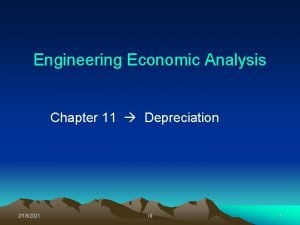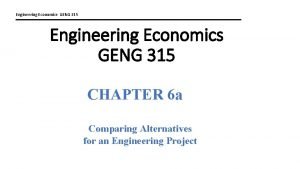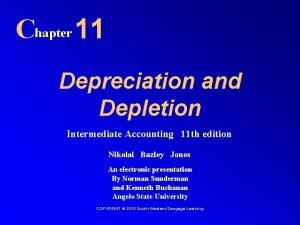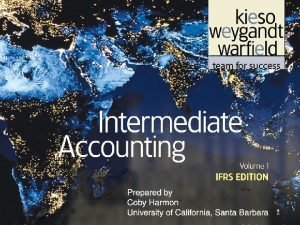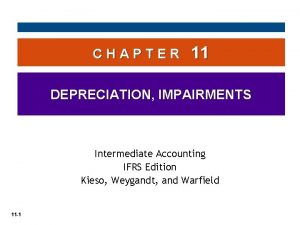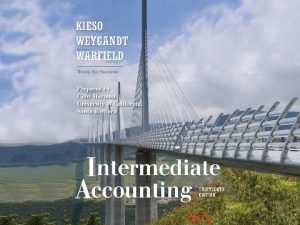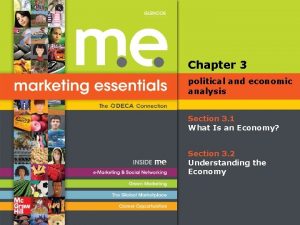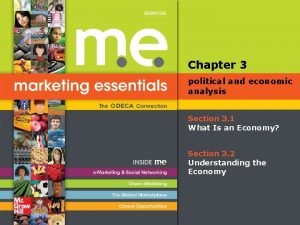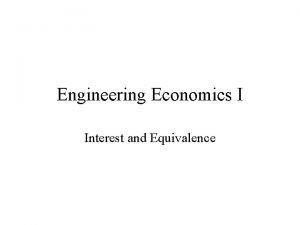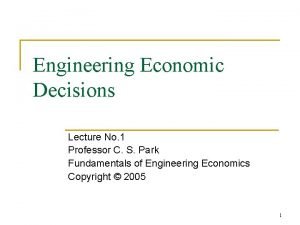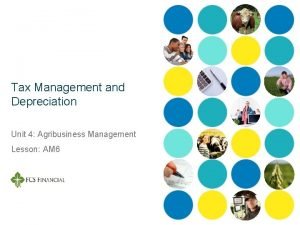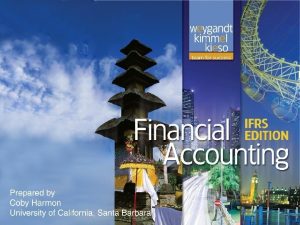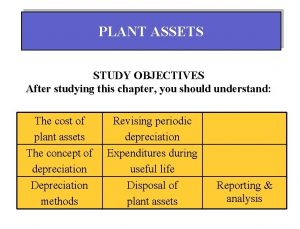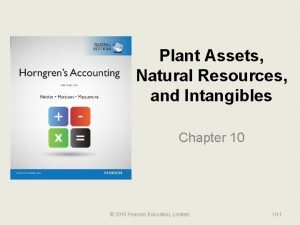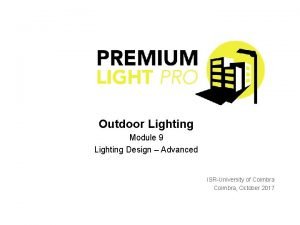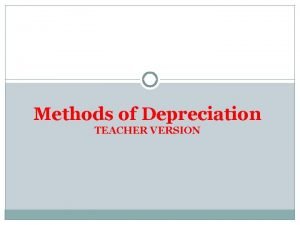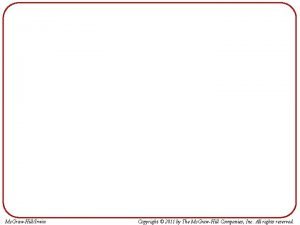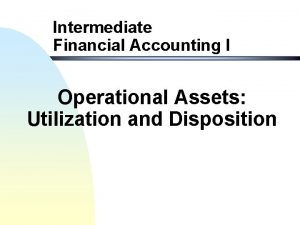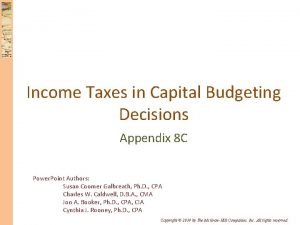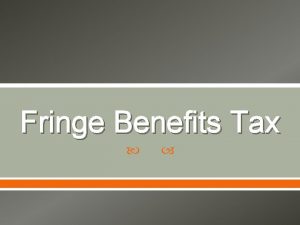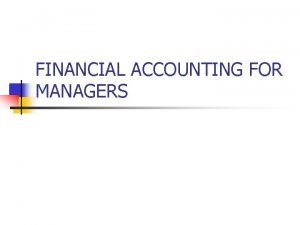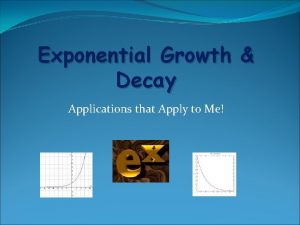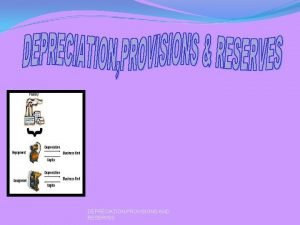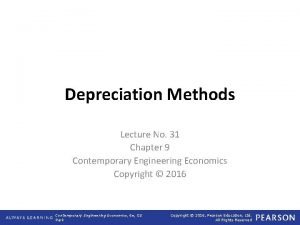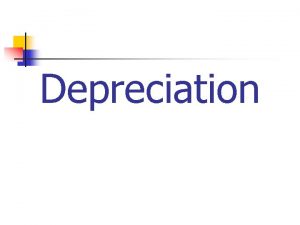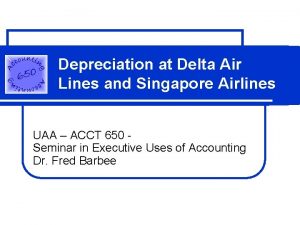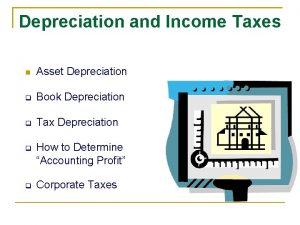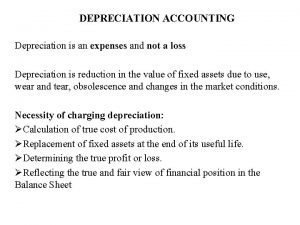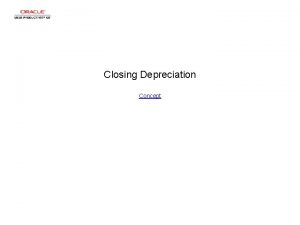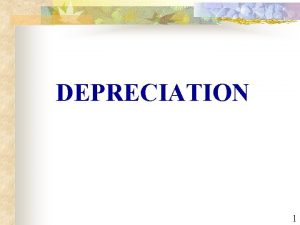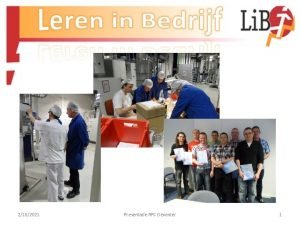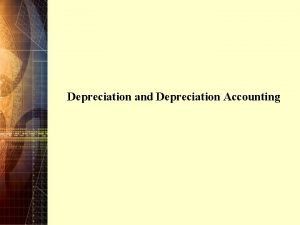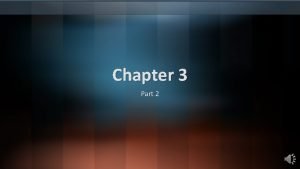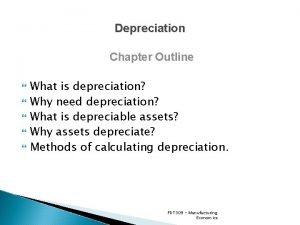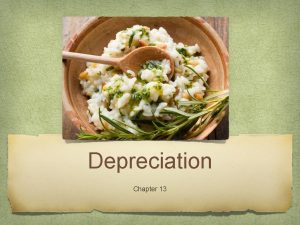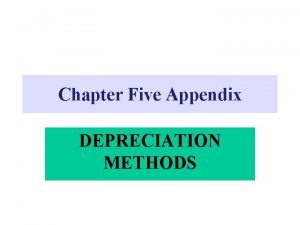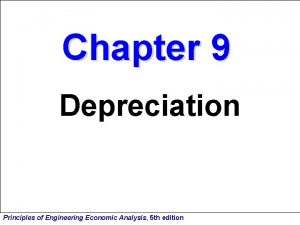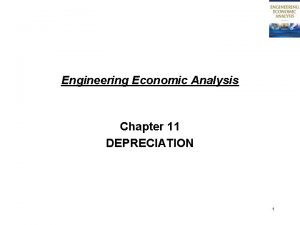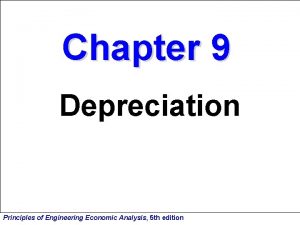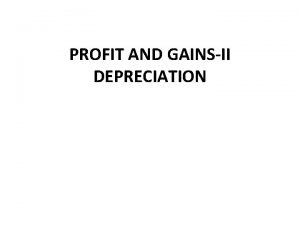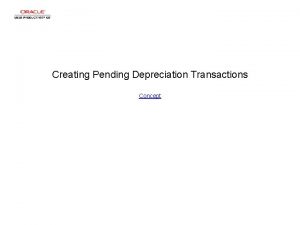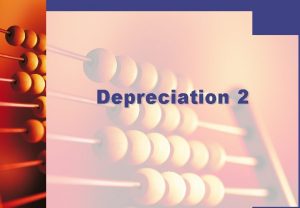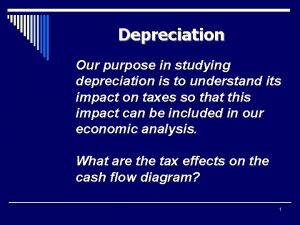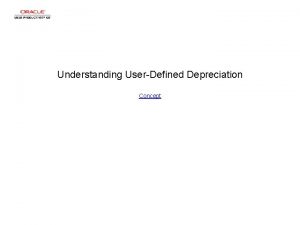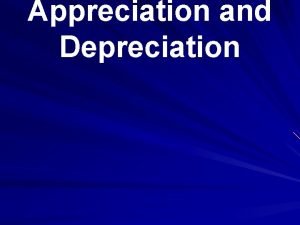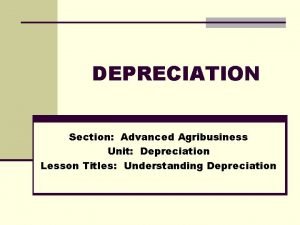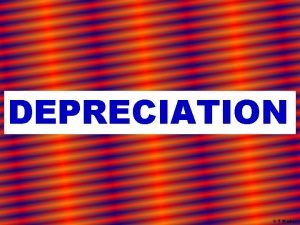Engineering Economic Analysis Chapter 11 Depreciation 2182021 rd































- Slides: 31

Engineering Economic Analysis Chapter 11 Depreciation 2/18/2021 rd 1

Physical Depreciation Economic Gradual decrease in utility in an asset with use and time Functional Depreciation Book Depreciation Accounting Systematic allocation of asset's value in portions over its depreciable life 2/18/2021 rd Tax Depreciation 2

Depreciation Property must 1. be used for business to produce income. 2. have a useful life. 3. be an asset that decays, gets consumed, wears out becomes obsolete or loses value to the owner from natural causes. Ergo, land is never depreciable, nor is clearing, grading, planting, and landscaping. 2/18/2021 rd 3

Cost Basis Total cost to cover the life of the asset to include freight, site preparation, installation, and training. Basic accounting principle is to match cost with revenue. 2/18/2021 rd 4

Cost Basis Cost of asset Freight Installation labor Site preparation Cost basis 2/18/2021 $50, 000 1, 000 2, 000 4, 000 $57, 000 rd 5

Cost Basis with Trade-in Old asset Less: trade-in Unrecognized gain $5, 000 6, 000 $1, 000 Cost of new asset Less: Unrecognized gain Freight Installation labor Site preparation Cost Basis 2/18/2021 rd $50, 000 (1, 000) 1, 000 2, 000 4, 000 $56, 000 6

Property Tangible (can be seen touched and felt) Real (land, buildings, attachments) Personal (equipment, furnishings, machinery) Intangible (has value that can neither be seen nor touched (patents, copyrights, trademarks and franchises) 2/18/2021 rd 7

Depreciation Methods Straight Line Sum of Years Digits Declining Balance (2, 1. 5 and 1. 25) Unit of production Percent Depletion MACRS 2/18/2021 rd 8

Straight Line Depreciation Given P is first cost, S is salvage value at the end of N years, annual depreciation charge (ADC), is computed as ADC = Example: P = 1000, S = 200, N = 4 years ADC = (1000 – 200) / 4 = $200 each year Cannot depreciate below salvage value. (st-line-table 1000 200 4) 2/18/2021 rd 9

SOYD Depreciation Sum of years digits with P = $1000 and S = $200 and N = 4 years. The sum of the years is 1 + 2 + 3 + 4 = 4*5/2 =10 Year 1 2 3 4 ADC (4/10) (1000 – 200) = $320 (3/10) (1000 – 200) = $240 (2/10) (1000 – 200) = $160 (1/10) (1000 – 200) = $ 80 Total ADCs = $800 (soyd-table 1000 200 4) 2/18/2021 rd 10

Declining Balance Declining balance rates are almost always double the rate of straight-line depreciation. Other rates are 1. 25 and 1. 5. Still one must never depreciate below salvage value. At double declining balance the ADC is * Book Value. Example: P = $1, 000, S = $200; N = 4 years, ddb = 2/N n 1 2 3 Bn-1 $1000 $ 500 $ 250 ADC Bn $ 500 $ 250 $ 25 $ 225 ST-LINE 4 $ 225 $ 200 ST-LINE Bn = P(1 - )n where is 2/N for double declining balance. (ddb 1000 200 4 2) 2/18/2021 rd 11

Optimal time to switch from Declining Balance to ST-Line P = $10, 000; N = 5 years; S = 0; = 40% Year Dn Bn 1 $4000 $6000 2 2400 3600 3 1440 2160 4 864 1296 5 518 778 St-Line is 10000/5 = 2000 => switch at year 4 to st-line. 2/18/2021 rd 12

Declining Balance D 1 = P D 2 = (P - P) = P(1 - ) D 3 = [P - P(1 - )] = P(1 - )2 Dn = P(1 - )n-1 TDB = D 1 +… + Dn = P[1 – (1 - )n] Bn = P – TDB = P(1 - )n Example: P = $10 K, N = 5 years, Salvage = $778 n 1 2 3 4 5 2/18/2021 Bn-1 $10000 6000 3600 2160 1296 ADC $4000 2400 1440 864 518 rd Bn $6000 3600 2160 1296 778 ST-LINE 13

Book Value Book value = Cost - Depreciation charges made to date. 2/18/2021 rd 14

Units-of-Production Example: You operate a truck with an estimated cost of $60, 000 for 200, 000 miles of life with a $7 K salvage value. During the year you used the truck for 25, 000 miles. ADC = (60 – 7)K * 25 K/200 K = $6625. 2/18/2021 rd 15

Activity Depreciation Example: Cost Depletion -- You buy a small forest for $500, 000; the land is worth $100, 000. The lumber is estimated to contain 2 million board feet (mbf). If you cut 0. 4 mbf, your depletion allowance is (500 – 100)K * 0. 4 / 2 = $80, 000 Activity depreciation is based on level of activity, not on time. 2/18/2021 rd 16

Percent Depletion A gold mine has 400, 000 ounces of gold on a basis of $50 M (cost – land). Gross annual revenue is $20 M from selling 50, 000 ounces. Mining expenses before depletion is $15 M. Gold has 15% depletion percentage. 20 M * 0. 15 = $3 M depreciation. Check taxes. Allowance is computed percentage or 50% of taxable income. Taxable Income = $20 M – $15 M = $5 M 0. 5 * 5 M = 2. 5 M Compare 2. 5 M with $3 M You must take the lesser of the two percentage depletions: $2. 5 M. Based on cost depletion: 50 M * 50 K/400 K = $6. 25 M. Best here to depreciate on cost depletion. 2/18/2021 rd 17

Year 1 2 3 4 5 6 7 8 9 10 11 12 13 14 15 16 17 18 19 20 21 2/18/2021 3 -year 33. 33 44. 45 14. 81* 7. 41 ------------------ 5 -year 20. 00 32. 00 19. 20 11. 52* 11. 52 5. 76 ---------------- 7 -year 14. 29 24. 49 17. 49 12. 49 8. 93* 8. 92 8. 93 4. 46 -------------- 10 -year 10. 00 18. 00 14. 40 11. 52 9. 22 7. 37 6. 55* 6. 55 6. 56 6. 55 3. 28 ----------rd 15 -year 5. 00 9. 50 8. 55 7. 70 6. 93 6. 23 5. 90* 5. 90 5. 91 2. 95 ------ 20 -year 3. 750 7. 219 6. 677 6. 177 5. 713 5. 285 4. 888 4. 522 4. 462* 4. 461 4. 462 4. 461 2. 231 18

MACRS 3 -Class SL = 1/3 DDB = 2/3 S = 0 Year Calculation MACRS Percentage 1 ½ * 2/3 = 1/3 or 33. 33% 2 2/3 * 2/3 = 4/9 or 44. 45% SL dep = (1 – 1/3)/2. 5 = 26. 67% 3 2/3 * (1 – 0. 7778) = 14. 81% SL dep (1 – 0. 7788)/1. 5 = 14. 81% 4 ½ * 14. 81% = 7. 41% In Year 3 SL depreciation DDB => Switch to SL 2/18/2021 rd 19

MACRS A taxpayer buys a $10 K 5 -year MACRS class asset. Compute the ADCs. If the asset were disposed in year 3, find the ADC for that year. (dmacrs 10000 5) $2000 3200 1920 1152 576 In year of disposal, take ½ of ADC = ½ * 1920 = $960 2/18/2021 rd 20

A 120 -room hotel is bought for $2. 5 M. A 25 -year loan is available for 12%. Study data shows Occupancy Probability 65% full 0. 4 70% 0. 3 75% 0. 2 80% 0. 1 The operating hotel costs are: Taxes and insurance $20 K annually Maintenance $50 K annually Operating $200 K annually The life of the hotel is 25 years when operating 365 days per year with salvage value $500 K. Neglect tax credit and income taxes. Determine the average rate to charge per room per night to return 15% of the initial cost per year. 2/18/2021 rd 21

Problem 11 -1 First cost = $10 K; S = $1600; Life 6 years; SOYD (SOYD-table 10 e 3 1. 6 e 3 6) n Bn-1 ADC Bn 1 10000 2400 7600 2000 5600 3 5600 1600 4000 4 4000 1200 2800 5 2800 2000 6 2000 400 1600 … continued 2/18/2021 rd 22

Problem 11 -1 First cost = $10 K; S = $1600; Life 6 years; DDB (DDB 10 e 3 1. 6 e 3 6 2) n Bn-1 ADC Bn 1 $10000. 00 $3333. 33 $6666. 67 2 $6666. 67 $2222. 22 $4444. 44 3 $4444. 44 $1481. 48 $2962. 96 4 $2962. 96 $ 987. 65 $1975. 31 $ 187. 65 * $1787. 65 ST-LINE 6 $1787. 65 $ 187. 65 $1600. 00 ST-LINE * May take $375. 30 in year 5. 2/18/2021 rd 23

Problem 11 -2 $1 M first cost has salvage value of $75 K after 6 years. Determine if SOYD or DDB is better at MARR = 12%. (SOYD 1 e 6 75 e 3 6) (list-pgf '(0 220238. 09 176190. 49 132142. 86 88095. 24 44047. 62) 12) $693, 233. 45 (DDB 1 e 6 75 e 3 6 2) (list-pgf '(0 333333. 34 222222. 22 148148. 14 98765. 42 65843. 61 43895. 74) 12) $ 702, 589. 76 2/18/2021 rd 24

Problem 11 -9 First cost = $1. 5 M with a 5 -year life and no salvage value. Find the MACRS depreciation. (dmacrs 1. 5 e (300000 480000 288000 172800 86400) 2/18/2021 rd 25

Problem 11 -16 (Depreciation 100 e 3 20 e 3 5 2) St Line 16000 16000 ---- 2/18/2021 SOYD 26666. 67 21333. 33 16000 10666. 67 5333. 33 ---- DDB 40000 24000 14400 8640 5184 ---- rd MACRS *** 20000 32000 19200 11520 5760 26

Depreciation Schedules Year A B C D 1 $323. 3 $212. 0 $424. 0 $194. 0 2 258. 7 339. 2 254. 4 194. 0 3 194. 0 203. 5 152. 6 194. 0 4 129. 3 122. 1 91. 6 194. 0 5 64. 7 122. 1 47. 4 194. 0 6 61. 1 970. 0 1060. 0 970. 0 _____ First cost = _____ Salvage = _____ (Depreciation 10000 1000 6 2) 2/18/2021 rd E $107. 0 216. 0 324. 0 216. 0 107. 0 970. 0 _____ 27

Depreciation Schedule n 1 2 3 4 5 6 7 8 A $8 K 8 K 0 B $22, 857 16, 327 11, 661 5, 154 0 0 First cost = _______ 2/18/2021 C $11, 429 19, 592 13, 994 9, 996 7, 140 3, 570 D $22, 857 16, 327 11, 661 8, 330 6, 942 0 Salvage value = ____ rd 28

Problem 11 -26 First cost is $20 K for a MACRS 3 -year class property sold in 2 nd year for $14 K. Find any depreciation recapture, ordinary losses or capital gains. (DMACRS 20 e 3 3) (6666 8890 2962 1482) Book value = 20 K – 6666 – 0. 5(8890) = $8889 MV 2 – BV 2 = 14 K – 8889 = $5111 (depreciation recapture) or ordinary gains. Gains (losses) = salvage value – book value Gains = Salvage value – book value = (salvage value – cost basis) + (cost basis – book value) capital gains ordinary gains 2/18/2021 rd 29

Example 11 -9 Cost basis is $10 K for MACRS 3 -year property disposed of after 5 years of operation for a) $7 K; 7 K - 0 = $7 K depreciation recapture (ordinary gains) b) $0; 0 – 0 => neither recapture nor loss c) Cost of $2 K; -2 K = -$2 K loss. (Dmacrs 10 e 3 3) (3333 4445 1481 741) 2/18/2021 rd 30

Example An asset costing $230 K in MACRS 7 -year class is sold at the end of 3 years for $150 K and is taxed at 34%. a) Find the gain or loss. b) Repeat if sold for $100 K a) (dmacrs 230 E 3 7) (32867 56327 40227 28727 20539 20516 20539 10258) 32867 + 56327 + ½ * 40227 = $109, 307. 50 (depreciation charges) BV 3 = 230 K - $109, 307. 50 = $120, 692. 50 BV 3 < 150 K < 230 K => no capital gains b) BV = $120, 692. 50 – 100 K = $20, 692. 50 loss => Tax savings 20. 692. 5 * 0. 34 = $7035. 45 Net = $107, 035. 50 2/18/2021 rd 31
 Depreciation in engineering economics
Depreciation in engineering economics Engineering economic analysis procedure
Engineering economic analysis procedure Chapter 11 depreciation impairments and depletion
Chapter 11 depreciation impairments and depletion What is the difference between depreciation and impairment
What is the difference between depreciation and impairment Kunci jawaban buku intermediate accounting ifrs chapter 11
Kunci jawaban buku intermediate accounting ifrs chapter 11 Chapter 11 depreciation
Chapter 11 depreciation Economic growth vs economic development
Economic growth vs economic development Conclusion of growth and development
Conclusion of growth and development Economic systems lesson 2 our economic choices
Economic systems lesson 2 our economic choices Chapter 3 political and economic analysis
Chapter 3 political and economic analysis Chapter 3 political and economic analysis
Chapter 3 political and economic analysis Engineering economics equations
Engineering economics equations Engineering economic decisions
Engineering economic decisions Macrs depreciation formula
Macrs depreciation formula Units-of-activity method of depreciation
Units-of-activity method of depreciation Double declining formula
Double declining formula Straight line method depreciation
Straight line method depreciation Isolux diagram for finding luminance on road surface is a
Isolux diagram for finding luminance on road surface is a Double declining method depreciation
Double declining method depreciation Double declining method depreciation
Double declining method depreciation Macrs depreciation formula
Macrs depreciation formula Depreciation tax shield in capital budgeting
Depreciation tax shield in capital budgeting Deemed depreciation fbt
Deemed depreciation fbt Accumulated depreciation journal entry
Accumulated depreciation journal entry Accounting definition
Accounting definition Exponential decay car depreciation worksheet
Exponential decay car depreciation worksheet Causes of depreciation
Causes of depreciation Macrs depreciation formula
Macrs depreciation formula Capital expenditures in accounting
Capital expenditures in accounting Singapore air lines
Singapore air lines Macrs depreciation formula
Macrs depreciation formula Depreciation in accounting
Depreciation in accounting
